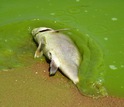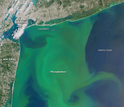More rainfall would lead to more algae blooms, dead zones
 An extensive algae bloom in Lake Erie in August, 2011 resulted from record-breaking nutrient loads. Credit and Larger Version |
July 27, 2017
Increased precipitation from a changing climate could pollute U.S. waterways with excess nitrogen, increasing the likelihood of severe water quality impairment from coast to coast, according to a new study by scientists Eva Sinha and Anna Michalak of the Carnegie Institution for Science and Venkatramani Balaji of Princeton University.
The results are published in this week's issue of the journal Science.
The effects will be especially strong in the Midwest and Northeast, the researchers found.
Rainfall and other precipitation washes nutrients from human activities like agriculture and fossil fuel combustion into rivers and lakes. When these nutrients overload waterways, a process called eutrophication, the results can be dangerous.
Harmful, toxin-producing algae blooms can develop, as well as dangerous low-oxygen dead zones. Over the past several years, dead zones and algae blooms in coastal regions across the United States -- including the Gulf of Mexico, the Chesapeake Bay and Florida -- have received extensive news coverage.
Sinha and Michalak used models to predict how climate change might affect eutrophication.
"In the 1970s, we discovered human-caused eutrophication and took steps to reverse its course," said Tom Torgersen, director of the National Science Foundation's Water, Sustainability and Climate program, which funded the research. "As this paper shows, however, even seemingly minor climate variations can result in a return to the eutrophication of the past. It will take more research to create better management strategies just to stay even."
In an earlier study, Sinha and Michalak found that, while land use and land management control the supply of nitrogen, precipitation controls how much of that nitrogen flows from the land into waterways.
They noted that the amount of precipitation plays a large role in determining how much nitrogen runoff happens during a given year.
In the current study, they used these insights to predict how future changes to precipitation caused by climate change will, in and of themselves, affect nitrogen runoff and thereby increase the risk of water quality impairment in the U.S.
The scientists leveraged projections from 21 different models and looked at three possible future scenarios.
They found that if trends in greenhouse gas emissions follow a "business-as-usual" scenario, the resulting changes in climate will alter precipitation patterns in the U.S. and increase nutrient pollution by one-fifth by the end of the century. The effects will be particularly strong in the Corn Belt and in the Northeast.
Offsetting the increased amount of nitrogen being washed into waterways would be an enormous task, requiring a whopping one-third reduction in overall nitrogen inputs, such as fertilizer use.
"Our findings demonstrate that it is imperative that water quality management strategies account for the effect of future precipitation changes on nitrogen loading," Michalak said.
Sinha's and Michalak's results are specific to the U.S., but the researchers have identified India, China and Southeast Asia as areas at high risk for large increases in nitrogen pollution due to increased precipitation.
"These are regions that more than half the world's population calls home, so severe water quality impairments could have serious effects," Sinha said.
-NSF-
Media Contacts
Cheryl Dybas, NSF, (703) 292-7734, cdybas@nsf.govNatasha Metzler, Carnegie Institution for Science, (202) 939-1142, nmetzler@CarnegieScience.edu
The National Science Foundation (NSF) is an independent federal agency that supports fundamental research and education across all fields of science and engineering. In fiscal year (FY) 2017, its budget is $7.5 billion. NSF funds reach all 50 states through grants to nearly 2,000 colleges, universities and other institutions. Each year, NSF receives more than 48,000 competitive proposals for funding and makes about 12,000 new funding awards.
Useful NSF Web Sites:
NSF Home Page: https://www.nsf.gov
NSF News: https://www.nsf.gov/news/
For the News Media: https://www.nsf.gov/news/newsroom.jsp
Science and Engineering Statistics: https://www.nsf.gov/statistics/
Awards Searches: https://www.nsf.gov/awardsearch/
NSF Home Page: https://www.nsf.gov
NSF News: https://www.nsf.gov/news/
For the News Media: https://www.nsf.gov/news/newsroom.jsp
Science and Engineering Statistics: https://www.nsf.gov/statistics/
Awards Searches: https://www.nsf.gov/awardsearch/

A Lake Okeechobee algae bloom in the summer of 2016. Water discharge led to more downstream blooms.
Credit and Larger Version

A large algae bloom off the Pacific Northwest coast occurred in July, 2014.
Credit and Larger Version
Guillermo Gonzalo Sánchez Achutegui
ayabaca@gmail.com
ayabaca@hotmail.com
ayabaca@yahoo.com
Inscríbete en el Foro del blog y participa : A Vuelo De Un Quinde - El Foro!




No hay comentarios:
Publicar un comentario